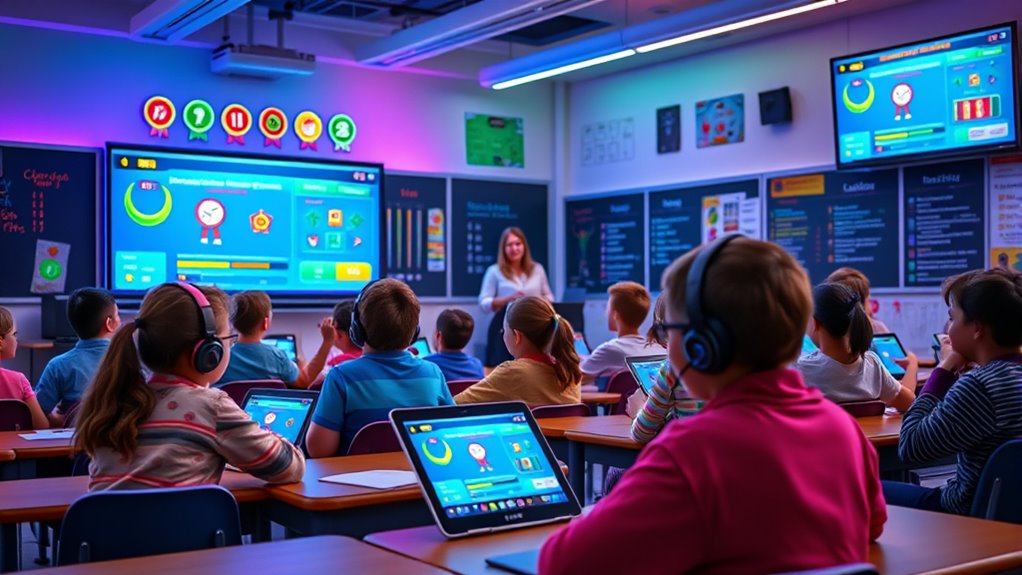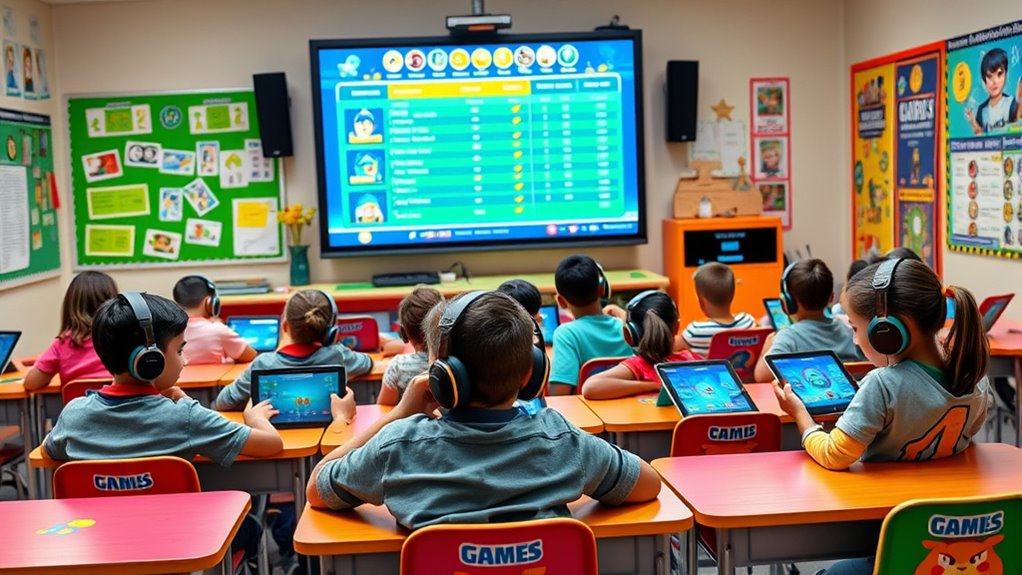Gamifying education transforms your classroom by adding game elements like challenges, rewards, and leaderboards to boost student engagement and motivation. It makes learning fun and interactive, turning routine tasks into exciting quests that encourage problem-solving and participation. This approach not only improves understanding and retention but also increases productivity and reduces boredom. If you keep exploring, you’ll discover how this innovative method can truly revolutionize your teaching experience.
Key Takeaways
- Incorporates game elements like rewards and challenges to boost student engagement and motivation.
- Transforms routine lessons into interactive, fun experiences that improve retention and understanding.
- Enhances performance with up to 89.45% achievement boosts and 300% higher homework completion rates.
- Increases productivity and participation by making learning feel like an adventure and reducing boredom.
- Leverages AI and automation to provide personalized feedback, streamline assessments, and support effective teaching.

Gamifying education is transforming the way students learn by adding game elements like challenges, rewards, and leaderboards to traditional classroom activities. This approach makes learning more engaging and interactive, tapping into your natural desire for achievement and social connection. When you incorporate game mechanics into lessons, you turn routine tasks into exciting quests that motivate you to participate actively. Challenges push you to solve problems, while rewards celebrate your progress, keeping you interested and enthusiastic to learn. Leaderboards introduce a friendly competition, encouraging you to improve your skills and reach new milestones. As a result, students are more likely to stay focused, attentive, and invested in their education, which boosts overall learning outcomes. Challenge-based gamification significantly outperforms traditional lecture methods, leading to remarkable improvements in student achievement.
Gamifying education boosts focus, motivation, and learning outcomes through challenges, rewards, and friendly competition.
The impact of gamification on student engagement is profound. It transforms the classroom from a passive environment into an energetic space where learning feels like a game. When lessons are gamified, you’re more likely to find the material fun and compelling, leading to increased motivation. Rewards and challenges provide immediate feedback, making it clear when you’re succeeding and what needs improvement. This constant reinforcement helps you stay committed and reduces boredom. In particular, gamified tools are effective across various subjects, maintaining your interest and excitement whether you’re working on math, science, or language arts. Elementary students, for example, often find math more enjoyable when it’s presented through interactive games that reward progress and mastery. Additionally, research shows that gamification can help students retain up to 90% of learned material, making it a powerful tool for long-term education. Incorporating AI-driven insights can further personalize the learning experience, boosting effectiveness.
Gamification doesn’t just make learning more fun; it also markedly improves your performance. Challenge-based gamification can increase your achievement levels by up to 89.45% compared to traditional methods. Overall, students tend to perform about 34.75% better when lessons are gamified. It promotes active learning by encouraging you to participate, explore, and apply new concepts. Complex topics become easier to understand because game elements simplify difficult ideas, making them accessible and engaging. Additionally, gamification helps boost your retention of knowledge, leading to better long-term understanding, especially in subjects like math where engagement is essential for success. Studies also indicate that gamification can increase homework completion rates by up to 300%, demonstrating its effectiveness in motivating consistent effort.
Beyond engagement and performance, gamification also enhances your motivation and productivity. Studies reveal a 50% improvement in student productivity when learning is gamified, and most learners—about 83%—feel more motivated during gamified training sessions. This approach makes learning feel less like a chore and more like an adventure, which increases your satisfaction and reduces feelings of boredom. It also streamlines classroom management for educators, who benefit from automated tracking, assessment, and personalized feedback. This efficiency allows teachers to focus more on teaching rather than grading, saving time and making lessons more effective. As gamification continues to grow, it promises to reshape education further, making learning more engaging, accessible, and effective for everyone.
Frequently Asked Questions
How Can Teachers Effectively Integrate Gamification Without Overwhelming Students?
You can effectively integrate gamification by starting small and gradually adding elements like points, badges, or challenges. Make sure to align game mechanics with learning goals, and provide clear guidance to prevent overwhelm. Keep the experience engaging yet balanced, offering support when needed. Regularly assess students’ responses, adjusting strategies to maintain motivation and deepen understanding without causing frustration or superficial participation.
What Are Common Challenges Faced When Implementing Gamified Learning?
When you implement gamified learning, you often face challenges like needing significant time, expertise, and resources. You might over-rely on external rewards, which can reduce students’ intrinsic motivation. Competition elements can cause stress and discourage collaboration. Additionally, gamification may oversimplify complex topics, limiting deep understanding. Limited resources and difficulty adapting content can also hinder engagement, making it essential to balance game elements thoughtfully with learning goals.
How Does Gamification Impact Long-Term Student Retention?
You might wonder how gamification affects long-term retention. It boosts memory by encouraging repeated exposure to material through engaging tasks. When you incorporate game elements like challenges, points, and feedback, you’re more likely to remember information longer. Gamification also makes learning enjoyable, motivating you to stay committed. As a result, you retain skills and knowledge better over time, leading to improved performance and deeper understanding.
Are There Specific Subjects That Benefit More From Gamification?
You’ll find that certain subjects, like STEM fields, benefit more from gamification due to their problem-solving and challenge-based nature. Computer science and math especially see significant improvements through interactive, challenge-driven platforms. These subjects often involve abstract concepts that gamification helps clarify and reinforce. Additionally, subjects requiring practical skills or real-world applications also gain from gamified experiences, boosting engagement, motivation, and retention.
How Can Parents Support Gamified Education at Home?
You can support gamified education at home by creating a fun, encouraging environment that promotes learning through play. Choose educational games that match your child’s interests, and regularly monitor their progress. Provide timely feedback and celebrate achievements to boost motivation. Incorporate game-based activities into daily routines, making learning continuous and engaging. Stay in touch with teachers and use digital tools to track development, adjusting support as needed for better outcomes.
Conclusion
So, next time you’re stuck in a dull classroom, just imagine turning your lessons into a game. Who knew that earning points, releasing levels, and battling bosses could make math and history more exciting? Just think: students trading textbooks for power-ups, all in the name of “learning.” It’s almost too good to be true—until your boss assigns you a “boss level” project. But hey, at least education’s finally catching up with the 21st century, right?










